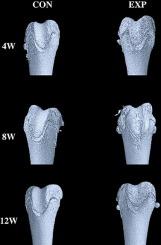Journal of Advanced Research ( IF 11.4 ) Pub Date : 2021-04-20 , DOI: 10.1016/j.jare.2021.04.006 Wei Lin 1 , Huijun Kang 1 , Yingzhen Niu 1 , Jinghui Niu 1 , Chongyi Fan 1 , Xunkai Feng 1 , Fei Wang 1

|
Introduction
Trochlear dysplasia is a commonly encountered lower extremity deformity in humans. However, the molecular mechanism of cartilage degeneration in trochlear dysplasia is unclear thus far.
Objectives
The PI3K/AKT signaling pathway is known to be important for regulating the pathophysiology of cartilage degeneration. The aim of this study was to investigate the relationship of the PI3K/AKT signaling pathway with trochlear dysplasia cartilage degeneration.
Methods
In total, 120 female Sprague-Dawley rats (4 weeks of age) were randomly separated into control and experimental groups. Distal femurs were isolated from the experimental group at 4, 8, and 12 weeks after surgery; they were isolated from the control group at the same time points. Micro-computed tomography and histological examination were performed to investigate trochlear anatomy and changes in trochlear cartilage. Subsequently, expression patterns of PI3K/AKT, TGFβ1, and ADAMTS-4 in cartilage were investigated by immunohistochemistry and quantitative polymerase chain reaction.
Results
In the experimental group, the trochlear dysplasia model was successfully established at 8 weeks after surgery. Moreover, cartilage degeneration was observed beginning at 8 weeks after surgery, with higher protein and mRNA expression levels of PI3K/AKT, TGFβ1, and ADAMTS-4, relative to the control group.
Conclusion
Patellar instability might lead to trochlear dysplasia in growing rats. Moreover, trochlear dysplasia may cause patellofemoral osteoarthritis; cartilage degeneration in trochlear dysplasia might be associated with activation of the PI3K/AKT signaling pathway. These results provide insights regarding the high incidence of osteoarthritis in patients with trochlear dysplasia. However, more research is needed to clarify the underlying mechanisms.
中文翻译:

软骨退变与发育性滑车发育不良大鼠实验模型中 PI3K/AKT 信号通路的激活有关
介绍
滑车发育不良是人类常见的下肢畸形。然而,目前尚不清楚滑车发育不良中软骨退变的分子机制。
目标
已知 PI3K/AKT 信号通路对于调节软骨退变的病理生理学很重要。本研究的目的是探讨 PI3K/AKT 信号通路与滑车发育不良软骨退化的关系。
方法
总共将 120 只雌性 Sprague-Dawley 大鼠(4 周龄)随机分为对照组和实验组。术后4、8、12周从实验组分离股骨远端;在同一时间点将它们与对照组分离。进行微计算机断层扫描和组织学检查以研究滑车解剖结构和滑车软骨的变化。随后,通过免疫组织化学和定量聚合酶链反应研究了软骨中 PI3K/AKT、TGFβ1 和 ADAMTS-4 的表达模式。
结果
实验组在术后8周成功建立滑车发育不良模型。此外,术后 8 周开始观察到软骨退变,与对照组相比,PI3K/AKT、TGFβ1 和 ADAMTS-4 的蛋白和 mRNA 表达水平更高。
结论
髌骨不稳定可能导致生长中的大鼠滑车发育不良。此外,滑车发育不良可能导致髌股骨关节炎;滑车发育不良中的软骨退变可能与 PI3K/AKT 信号通路的激活有关。这些结果为滑车发育不良患者骨关节炎的高发病率提供了见解。然而,需要更多的研究来阐明潜在的机制。










































 京公网安备 11010802027423号
京公网安备 11010802027423号